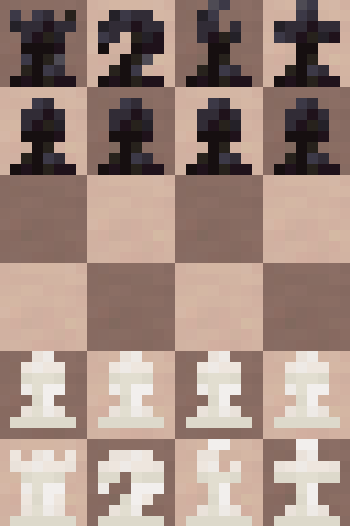▪───────▪
✶ ▪───────▪
A
....GAME
....OF
K I N G ' S....M A R C H
───────────────────────────────────────────────────────
King's March is a strategic game featuring a 4-by-6 checkered board. Each side has eight pieces: four serfs, one tower, one paladin, one priest, and one king. Unlike more mundane versions of chess, there is no queen. The shape of the board simulates the arduous march of a king and his army to war. Pieces are normally either white or black, though they may be of any color as long as it is opposing colors.
▪───────▪ ✶ ▪───────▪
Pieces
▪───────▪ ✶ ▪───────▪
.........Four serfs gather on the front for each side. They can only move forward, never to the back or sides. They can only move one spot at a time. Serfs may only capture other pieces diagonally. An opposing serf, upon reaching the enemy's side, may be promoted to fill in the spot of a fallen paladin or priest; if neither a paladin nor a priest has fallen, the serf cannot be promoted. On the outer left-hand side is a tower. A tower may only move up and down or to the sides as far as they like, as long as nothing is blocking its path. Next to it, on the right, is a horse-mounted paladin. They may only move in an L-shaped pattern (one over, three out, and vice versa), regardless of their direction; it is the only piece that can move over other pieces. To the right of the paladin is the holy priest. The priest's Dictus grants them the ability to move diagonally, in one direction at a time, as far as they'd like, as long as any other pieces do not block their path. Finally, in the right-hand corner is none other than the king. The king is the only piece that may move in whatever direction it likes, one spot at a time, as long as its desired spot is not occupied by its kind.
▪───────▪ ✶ ▪───────▪
Stalemates
▪───────▪ ✶ ▪───────▪
.........After the check, a player may win with a checkmate. Checkmate is when the king is placed in check and cannot escape check. However, this can be mistaken for a stalemate. A stalemate, or draw, occurs when a king cannot legally move from his unchecked spot without resulting in a check. To avoid a stalemate, give your opponent at least two spaces to freely move around while you bring a second piece in for the final blow. A stalemate may also occur if moving any pieces guarding the king leaves the king open to an immediate and inescapable check on your opponent's turn.
───────────────────────────────────────────────────────
WRITTEN RAINSWRATH, 1529
[OOC]
All rules of real-life chess apply, with few exceptions:
- A serf (pawn) cannot double-move at all.
- A tower (rook) cannot castle with a king.
- There is no queen piece.
(Dec, 7, 2022)


